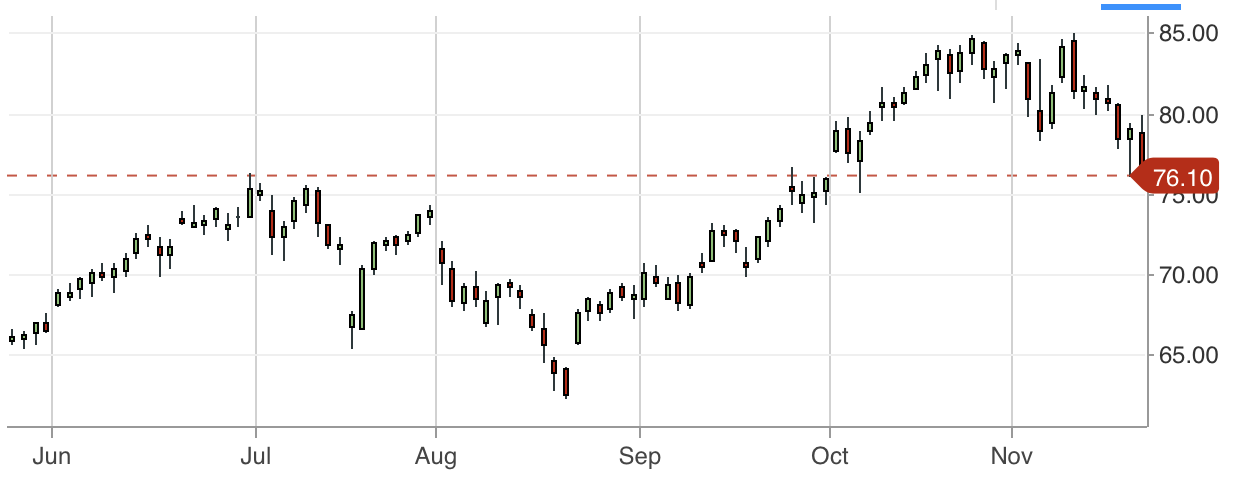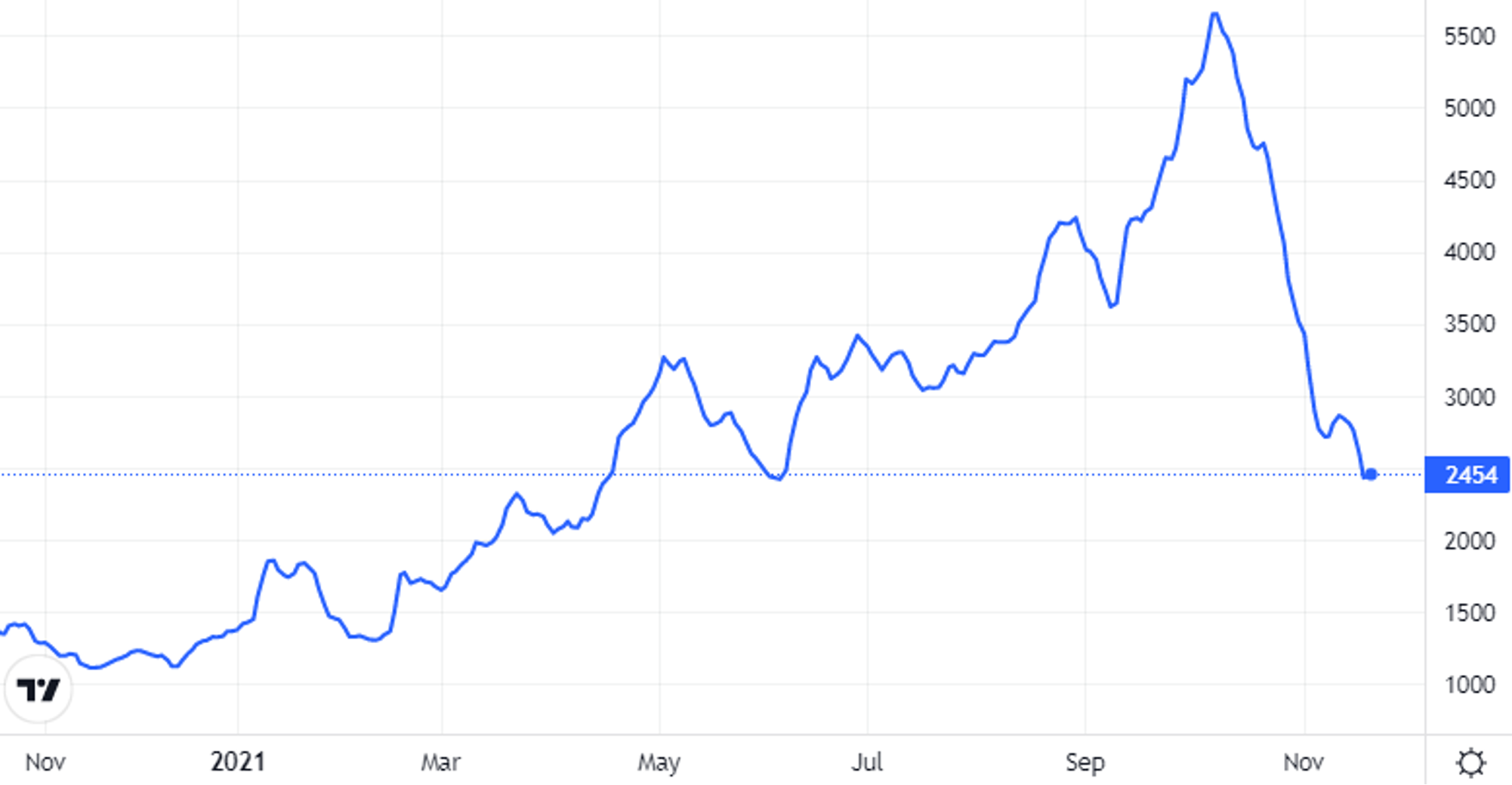
UCLA Anderson Forecast
Exhibit 1: WTI Crude Oil at Six-Week Low

Exhibit 2: Baltic Dry Index is Down ~50% from October Peak



Vernon Henderson
Professor of Economic Geography at the London School of Economics
This month, our podcast features a conversation with Vernon Henderson, Professor of Economic Geography at the London School of Economics. Professor Henderson is one of the world’s leading urban economists. We talk with him about the future of cities.
Leo Feler: I’d like to ask you a few questions about the future of cities, and specifically how the experience from this pandemic might change the future of cities. Starting off with the big picture, why do cities exist? What are the trade-offs when we think about living in cities versus living in suburbs or more remote areas?
Vernon Henderson: Economists, starting about 130 years ago, started writing about why we have cities. The main reason is agglomeration benefits that increase productivity when people cluster together. There are what we call “information spillovers” – you learn by observing what other people are doing, from talking with them, by meeting them in coffee shops, by seeing what gets shipped into their firms and what gets shipped out. We also think about trade, in reducing the distance to make it easier to do special orders. We think about hiring and how we find people that you want to hire in the local area. We think of this as really working face-to-face. There are also public service provisions with large scale economies in things like providing water mains and sewer mains. These are very expensive to do in rural areas. The disadvantage of cities is the high cost of living. You have a bunch of people living close together, let’s say if you live in the center of Manhattan, you pay high rents. Why do you pay high rents? Because if you don’t live in the center of Manhattan, you’re going to have to live somewhere much further away, you’re going to have to commute a very long distance. So, the people who live in the center of Manhattan pay high rents because they don’t have to commute. We also now know that bigger cities – and this is based on research in developing countries – present certain quality-of-life and health issues. People tend to have higher blood pressure, higher BMI, greater incidence of diabetes as you go up in terms of urban density and city size.
Leo Feler: You have a paper that looks at creative jobs in advertising, focusing on networking on Madison Avenue in New York. This paper is from the early 2000s, before you have Zoom, but after you have internet and emails. Why are these advertising firms co-locating so closely to one another? Is it just creative jobs that have this benefit of co-location? What are the big takeaways from your paper?
Vernon Henderson: An advertising agency’s traditional role was to serve as an intermediary between firms that wanted to place an ad in some form of media and the media outlets. The agency would do the placement and make that negotiation. To some extent that still holds for very big advertising firms that are doing huge media contracts. But smaller firms, which is what we focused on in the paper, have a more creative function of doing ads. The way we thought of it is, you get a request for a proposal to design an advertising campaign. Maybe several other firms have gotten that. You’re in lower Manhattan, there are 1,000 firms, roughly. You have a set of contacts, and usually neighbors that you interact with that may advise you about this request for proposal, because they won’t be doing the same request. You try and design a potential campaign. You trade a lot of information with your neighbors. What we find in the paper is that people – when they’re deciding where to locate – they want to locate in a cluster with other advertising agencies like themselves. They’re willing to pay considerably higher rents in order to do that. But, we infer that these benefits of being close to other firms dissipate very quickly. If you’re within 250 meters or 500 meters, that’s really good. If you’re more than 700 meters, these benefits die out. That was based on face-to-face interaction.
Leo Feler: Zoom is pervasive right now. It’s much easier to get people collaborating on Zoom or Skype or Teams. It’s almost become an institutional staple over this past year and a half, and it doesn’t seem like that’s going to be changing any time soon. Does the ability to interact remotely through Zoom or Skype or Teams change the nature of agglomeration economies, and by extension, does that change the nature of cities?
Vernon Henderson: The original research on this before Zoom was about using the internet in general, versus face-to-face interaction. The idea was that these were compliments, not substitutes. With the internet, you have variety and see a variety of opportunities where you might buy things, interact with different people, and so on. But to really make that work, you needed to meet them face-to-face. So, to some extent we think “well, you can meet them on Zoom.” That can substitute for face-to-face. But, you think of the experience that we’ve had on Zoom. A lot of what we’re doing is living off of past contacts. I know you, Leo, historically quite well. We can do this on Zoom, but that’s based on a past contact. Looking to the future, the last year and a half, we’ve been living on those past contacts. You do meet new people on Zoom, but you meet them briefly maybe, you have a brief conversation, you can’t really see their body language, you don’t have an extensive interaction. You’re not going out to coffee with them, you’re not having a meal with them. You’re not meeting in another room, you’re meeting on Zoom where one person talks and people occasionally jump in. But you’re not meeting in a room where there’s a freer sense of discourse. Certainly, Zoom is going to be part of our lives. I’m a researcher, I work on big research teams that are around the world. Right now, we have a project that’s based in Tanzania. The principals are at the London School of Economics, but we meet once a week on Zoom. I’m in the US right now. Another principal is in Switzerland. We have employees in Tanzania. If we could still travel, do face-to-face and go to Tanzania, it would make things easier, but these are contacts that we’ve known for a long time. That’s why we can do this project. If we were starting from scratch and trying to do a project in Tanzania just over Zoom, it wouldn’t happen. We would have to have gone down there, spent time in the field, gotten to know the team, established a relationship, that’s all face-to-face. Zoom is going to make our lives easier in some ways, to have less travel and less commuting, but the face-to-face part is not going to go away.
Leo Feler: That seems especially relevant right now. As this pandemic continues now for over a year and a half, you start having a lot of turnover at firms. You start having a lot of new employees coming in who have never had the face-to-face interaction. They can’t rely on historical interactions and historical relationships to make their Zoom interactions more productive. When we think about the impact this is going to have on cities in the US, do you see cities in the US perhaps having slower growth, if people aren’t coming in as often, or if people are coming in only to establish those initial relationships, and then they’re working from home the remainder of the time, does this change what cities have to offer?
Vernon Henderson: There’s a bunch of different kinds of economic activities. We’re really talking about activities that are what’s called business services – where it isn’t a physical product, and it isn’t a personal service. So, we know manufacturing can’t be done on Zoom, you can’t get your hair cut on Zoom, you can’t eat a meal from a restaurant on Zoom. We’re talking about a particular set of activities. People have discovered that if you don’t commute, you save a lot of time. If you can do a lot of your work remotely on a computer, and then interact on Zoom, you save a lot of time by not commuting. We seem to be moving toward a world for these particular kinds of economic activities where you don’t have to go in every day. You can go in twice a week, three times a week. The rest of the time, you can work at home. That means for businesses, their use of office space is potentially going to change. For example, the United Nations is talking about having employees work remotely and maybe come in to meet once a month or once every six months. That will save them a lot on office space. If fewer people are coming in every day to downtown areas, there’s going to be less demand for the services that these people would have consumed, like where you have lunch or where you get your hair cut or whatever you did when you were downtown that now you might do somewhere else. This is probably not a time in many big cities where we want to be building more office space. We’re going to have a release of office space, an increase in vacancy, and maybe a reconfiguration of how that space is used. I don’t know whether that’s permanent. There was an article about Price Waterhouse – they are asking their employees to commit to whether they want to work remotely, in essence forever, or whether they still want to keep coming into the office. In a couple of years from now, will they turn around and say to those people who chose to work remotely, “this isn’t working out, we’ve lost contact with you, we know the people coming into the office well, it’s hard to launch new ventures with you….” It seems that there’s something to think about here, where we can reduce the number of days we commute in, but for most activities to work remotely all the time, that might become problematic.
Leo Feler: When we think about big cities, we also think about them providing social benefits like mentorship, helping people develop networks, helping people meet their future spouses. If you’re a young analyst at Price Waterhouse, and you’re remote all the time, how do you develop this professional network? How do you meet people who are going to be your partners later in life? How do you develop professional friendships? It seems incredibly hard to do that when everyone is looking at a screen and isolated in their homes.
Vernon Henderson: I agree. Somebody I know who’s employed at Berkeley, at a research institution, and does scientific writing, she’s been remote now for the last year and a half. She lives on her own, and she’s been remote for the last year and a half. Of the friends that she had made, a number of them left Berkeley because of the pandemic and moved to other places. It’s hard to meet new people. It’s hard to socialize with your colleagues, because it’s all on Zoom. It really narrows your life to some degree. On the other side, there are couples with kids, and commuting is very costly for them. If they’re able to stay home a couple of days a week and work from home, that’s really convenient for their lives.
Leo Feler: Perhaps this is something that will have different life stages. So, during someone’s early life stages, they’re going into the office 4-5 days a week, they’re developing their professional and social networks. Their bosses and mentors are coming in less frequently, they’re interacting with them on Zoom. It’s hybrid in two senses of the word. It’s hybrid in the sense that people are staying at home sometimes, going into the office and working sometimes. But also, during your early career you’re coming in much more frequently, but later in your career, as you’re having kids, as you’re managing teams in several different locations – it makes more sense to be on Zoom and be able to jump into meetings taking place with people in various locations, which you wouldn’t be able to do as much in a non-Zoom world.
Vernon Henderson: I agree with that. That’s an interesting point about career stage. Fifty years ago, people chose a career and they stayed in it their entire working life. Now people switch careers a lot, they switch jobs a lot. There’s more mobility across jobs and careers. Will that be harder with Zoom? I suspect it is. It could be in a particular job that when you start out, you go in quite a bit, you try to meet people, even the ones who are working mostly remotely. You try and establish contacts, you get a more defined set of tasks assigned to you or you choose to take on a more defined set of tasks, and as you said, you can do many of those remotely over time. Again, it’s not going to eliminate the face-to-face and the need to go into the office, but it’s going to eliminate the regular commute – how far and how often you have to commute.
Leo Feler: Do you think this helps equalize where a lot of creative production takes place? For example, during the pandemic, we saw smaller cities – Boise, Nashville, Fresno, Sacramento – gain a lot of population, and these cities had some of the largest increases in home prices. This is a signal that people believe that these cities are going to be doing well not just now, but if they’re willing to bid up housing prices and take out 30-year mortgages and move out to these locations, it’s a signal that they envision these places doing well in the long term. What’s your view on this shift away from some of the largest superstar cities towards second-tier cities, whether or not that’s sustainable?
Vernon Henderson: I’ll give you my reaction by giving an example. I sold my home in Providence, Rhode Island this spring because the market was so hot. We were told the person who bought our home was someone who had sold a property in New York City, came to Providence with cash from that sale, and paid cash for our house. The idea was that people with a reduced need to be in Manhattan could move further away from New York, be closer to family, be in an environment that might be better for their kids, with better schools and less of the grime and crime of some parts of big cities, and be in a home with more space. One of the things with Zoom and working from home is that people decide they need more space, because they want to have a more dedicated office space, a space where they can talk that’s not in their living room where other family members might come through. I do think there’s going to be this rearrangement of space to a degree, in the economic activities where this is relevant. Does that make Providence more creative or productive? I’m not sure it does. Creativity is still centered in New York. You have people commuting there now not every day, but perhaps once a week, getting on the train and going down, and the creativity is still centered in New York. That’s the way I would think about it.
Leo Feler: I want to bring one final data point here. We’ve been talking about a labor shortage in the US and how hard it is to find workers for service jobs. One of the things we haven’t looked at is the disaggregation of where it’s hard to find workers. To your point, if people are moving from Manhattan to Providence, Rhode Island, there needs to be this follow-on step of being able to get more service workers in Providence, Rhode Island, and now there’s a glut of service workers in downtown Manhattan. And that’s the reallocation that we think is very difficult, that will still take a lot of time. Overall, across the country, the leisure and hospitality sector might have a surplus of workers, but that surplus exists in Manhattan, and it doesn’t exist in Providence.
Vernon Henderson: That’s a good point. One way to think about it is that it’s almost what we call the economics of regime switch. People in the US work extremely long hours compared to Europe. Suddenly, you have a pandemic, you’re stuck at home, you’ve started to develop other activities, maybe you start to appreciate the leisure time you have in the pandemic, and maybe you decide – “I was crazy to be doing these jobs.” The interesting thing is it seems that everywhere you look, there is this problem of getting people to come back to work. Even now that unemployment benefits have ran out, there has still been a very slow return to the workforce. It’s not clear where that’s going to go. Maybe it will come back and we’ll all be in the rat race again and running in the mill, compared to European countries and other parts of the world. The point you make about reallocation, yes, I think that’s really right. You’ve got these service workers and service firms in downtown Manhattan, their business has dropped. There’s more demand for these services now in Providence, but not enough service workers in Providence to meet this demand.
Leo Feler: Vernon, thank you so much. This was very insightful. I’m glad we were able to catch up and have this conversation.